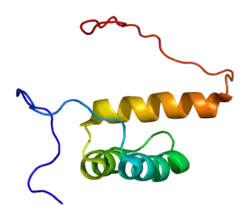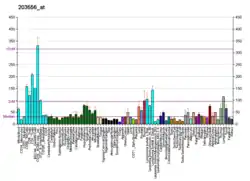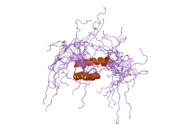ZHX2
Zinc fingers and homeoboxes protein 2 is a protein that in humans is encoded by the ZHX2 gene.[5][6][7]
The members of the zinc fingers and homeoboxes gene family are nuclear homodimeric transcriptional repressors that interact with the A subunit of nuclear factor-Y (NF-YA) and contain two C2H2-type zinc fingers and five homeobox DNA-binding domains. This gene encodes member 2 of this gene family. In addition to forming homodimers, this protein heterodimerizes with member 1 of the zinc fingers and homeoboxes family.[7]
See also
References
- GRCh38: Ensembl release 89: ENSG00000178764 - Ensembl, May 2017
- GRCm38: Ensembl release 89: ENSMUSG00000071757 - Ensembl, May 2017
- "Human PubMed Reference:". National Center for Biotechnology Information, U.S. National Library of Medicine.
- "Mouse PubMed Reference:". National Center for Biotechnology Information, U.S. National Library of Medicine.
- Nagase T, Ishikawa K, Suyama M, Kikuno R, Hirosawa M, Miyajima N, Tanaka A, Kotani H, Nomura N, Ohara O (May 1999). "Prediction of the coding sequences of unidentified human genes. XII. The complete sequences of 100 new cDNA clones from brain which code for large proteins in vitro". DNA Res. 5 (6): 355–64. doi:10.1093/dnares/5.6.355. PMID 10048485.
- Kawata H, Yamada K, Shou Z, Mizutani T, Yazawa T, Yoshino M, Sekiguchi T, Kajitani T, Miyamoto K (Jul 2003). "Zinc-fingers and homeoboxes (ZHX) 2, a novel member of the ZHX family, functions as a transcriptional repressor". Biochem J. 373 (Pt 3): 747–57. doi:10.1042/BJ20030171. PMC 1223552. PMID 12741956.
- "Entrez Gene: ZHX2 zinc fingers and homeoboxes 2".
Further reading
- Strausberg RL, Feingold EA, Grouse LH, et al. (2003). "Generation and initial analysis of more than 15,000 full-length human and mouse cDNA sequences". Proc. Natl. Acad. Sci. U.S.A. 99 (26): 16899–903. doi:10.1073/pnas.242603899. PMC 139241. PMID 12477932.
- Kawata H, Yamada K, Shou Z, et al. (2004). "The mouse zinc-fingers and homeoboxes (ZHX) family; ZHX2 forms a heterodimer with ZHX3". Gene. 323: 133–40. doi:10.1016/j.gene.2003.09.013. PMID 14659886.
- Gerhard DS, Wagner L, Feingold EA, et al. (2004). "The Status, Quality, and Expansion of the NIH Full-Length cDNA Project: The Mammalian Gene Collection (MGC)". Genome Res. 14 (10B): 2121–7. doi:10.1101/gr.2596504. PMC 528928. PMID 15489334.
- Lim J, Hao T, Shaw C, et al. (2006). "A protein-protein interaction network for human inherited ataxias and disorders of Purkinje cell degeneration". Cell. 125 (4): 801–14. doi:10.1016/j.cell.2006.03.032. PMID 16713569. S2CID 13709685.
- de Andrade TG, Peterson KR, Cunha AF, et al. (2006). "Identification of novel candidate genes for globin regulation in erythroid cells containing large deletions of the human beta-globin gene cluster". Blood Cells Mol. Dis. 37 (2): 82–90. doi:10.1016/j.bcmd.2006.07.003. PMID 16952470.
- Liu G, Clement LC, Kanwar YS, et al. (2007). "ZHX proteins regulate podocyte gene expression during the development of nephrotic syndrome". J. Biol. Chem. 281 (51): 39681–92. doi:10.1074/jbc.M606664200. PMID 17056598.
- Hu S, Zhang M, Lv Z, et al. (2007). "Expression of zinc-fingers and homeoboxes 2 in hepatocellular carcinogenesis: a tissue microarray and clinicopathological analysis". Neoplasma. 54 (3): 207–11. PMID 17447851.
This article is issued from Wikipedia. The text is licensed under Creative Commons - Attribution - Sharealike. Additional terms may apply for the media files.






